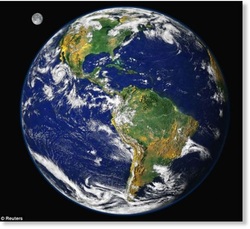
The presence of liquid water on the surface is what makes our 'blue planet' habitable, and scientists have long been trying to figure out just how much water may be cycling between Earth's surface and interior reservoirs through plate tectonics. They now believe reservoirs 400 miles under the surface hold the key.
* Ingredients for water are bound up in rock deep in the Earth's mantle
* Scientists claim the find may represent the planet's largest water reservoir
* It is believed to cover most of the U.S - 400 miles below the surface
* Researchers will now carry out further tests to discover if the water wraps around the entire planet
The Earth's largest expanse of water isn't on the surface of the planet, but instead is buried deep within its mantle, researchers have found. They claim the ingredients for water are bound up in deep rocks, and scientists believe the discovery may represent the planet's largest water reservoir. Deep pockets of magma were found using seismic waves beneath North America, and this magma is said to be a clear sign of water. So far, researchers claim they only have evidence the water sits beneath the U.S., but they plan to carry out further tests to see if it wraps around the entire planet.
The presence of liquid water on the surface is what makes our 'blue planet' habitable, and scientists have long been trying to figure out just how much water may be cycling between Earth's surface and interior reservoirs through plate tectonics.
Northwestern geophysicist Steve Jacobsen and University of New Mexico seismologist Brandon Schmandt say the findings, to be published June 13 in the journal Science, will aid scientists in understanding how the Earth formed, what its current composition and inner workings are and how much water is trapped in mantle rock.
'Geological processes on the Earth's surface, such as earthquakes or erupting volcanoes, are an expression of what is going on inside the Earth, out of our sight,' said Jacobsen, a co-author of the paper 'I think we are finally seeing evidence for a whole-Earth water cycle, which may help explain the vast amount of liquid water on the surface of our habitable planet. 'Scientists have been looking for this missing deep water for decades.'
Scientists have long speculated that water is trapped in a rocky layer of the Earth's mantle located between the lower mantle and upper mantle, at depths between 250 miles and 410 miles. Jacobsen and Schmandt are the first to provide direct evidence that there may be water in this area of the mantle, known as the 'transition zone,' on a regional scale. The region extends across most of the interior of the United States.
Schmandt and Jacobsen's findings build on a discovery reported in March in the journal Nature in which scientists discovered a piece of the mineral ringwoodite inside a diamond brought up from a depth of 400 miles by a volcano in Brazil. That tiny piece of ringwoodite - the only sample in existence from within the Earth - contained a surprising amount of water bound in solid form in the mineral.
Source: Science
Read the whole story at : http://www.dailymail.co.uk/sciencetech/article-2656635/Forget-Oceans-researchers-Earths-biggest-water-reservoir-BENEATH-United-States.html
or http://www.sott.net/article/280395-Earths-largest-water-reservoir-is-found-trapped-in-rock-400-miles-under-the-surface
 RSS Feed
RSS Feed